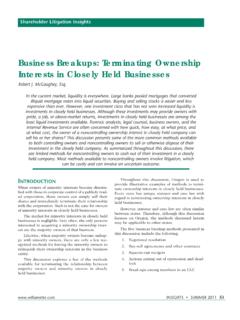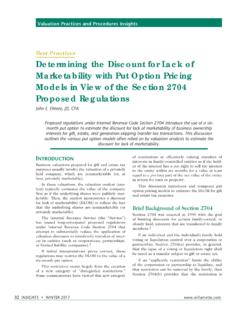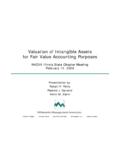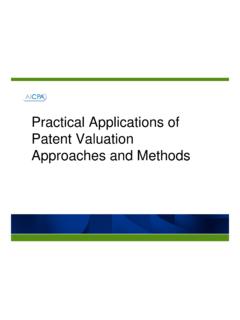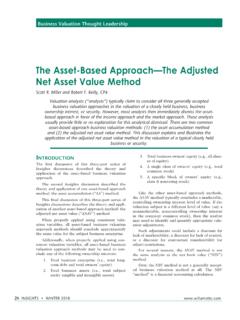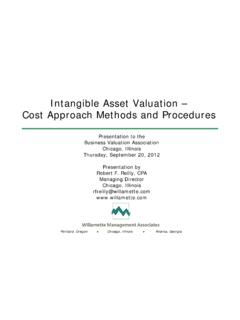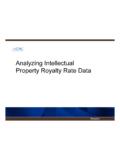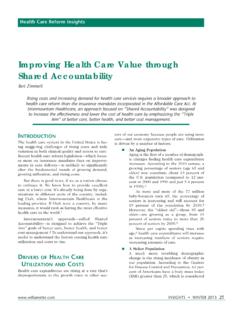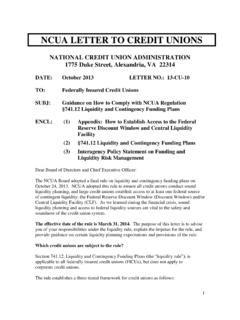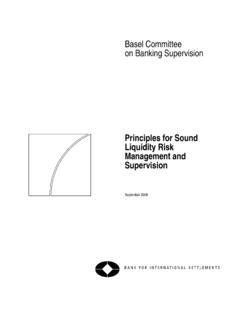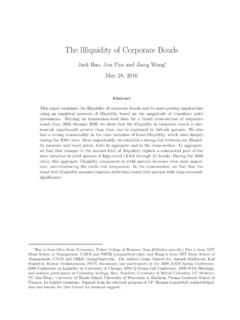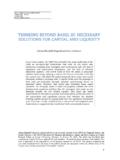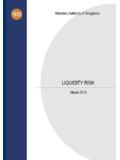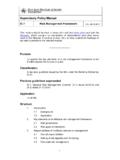Transcription of Quantifying the Private Company Discount: …
1 JANUARY 2015 Vol. 16, Issue No. 1 Reproduced with permission from Business Valuation Alert, published and copyrighted by Wolters Kluwer 2700 Lake Cook Road, Riverwoods, IL 60015 Quantifying the Private Company discount : Multiples Approach and Acquisition ApproachBy Kevin M. Zanni, ASA, CBA, CVA, CFEI ntroductionPrivate Company valuation is typically performed by BV professionals who regularly estimate the value of nonmar-ketable interests. In order to develop a valuation estimate, BV professionals review and interpret empirical evidence to support decision making. For example, for the valuation of nonmarketable interests within the context of a fair mar-ket value business valuation there is typically a valuation consideration related to the discount for lack of marketability (DLOM). That valuation consideration is often based on em-pirical data as interpreted and applied by a BV professional. Empirical data is primarily derived from equity studies.
2 Widely used equity studies support DLOM decision making through analysis of restricted stock transactions and initial public offering (IPO) pricing. Empirical data from restricted stock studies is based on a comparison of the price at which a public Company issues restricted stock to its publicly traded stock price. Empirical data from IPO studies are based on a comparison of an IPO share price with the price paid for shares in a Company before it went public. Relying on data from public companies to estimate the DLOM related to Private companies, while very much relevant and commonly used in practice, has its limitations. That is because restricted stock and IPO studies are based on studies of public Company equity pricing, and not on Private Company equity pricing. Some professionals argue that a more direct method may be appropriate. Of course, in addition to using restricted stock and IPO data, a Private Company security valuation analysis will typically consider additional methods in order to quantify or qualitatively address DLOM selection.
3 Additional DLOM support may include the consideration of published studies that rely on data from Private companies to derive a Private Company discount (PCD). Though less commonly discussed within the valuation profession, PCD studies may provide a more transparent means for estimating the DLOM faced by investors in Private companies. These studies suggest that Private companies typically sell at lower transaction pricing multiples than similar public companies. Several authors suggest possible reasons as to why Private companies sell at lower transaction multiples; however, some authors attribute the reason to the lack of liquidity or lack marketability of Private companies. This article will summarize PCD empirical studies and discuss the merits of the two different approaches used by these stud-ies. If judiciously applied, the PCD may help an analyst support the selection of a discount for lack of marketability.
4 It also stands to reason that an analyst may consider PCD evidence prior to, and in support of, selecting a financial fundamental multiple to use in a guideline publicly traded Company market approach analysis. Private Company discount StudiesThere are two primary methods used to identify PCD evidence: the multiples approach and the acquisition approach. Both ap-proaches are based on a comparison of financial fundamental transaction multiples (FFTM) such as transaction value as divided by earnings before taxes depreciation and amortization (EBITDA) and transaction value as divided by sales of pri-vate companies to publicly traded companies to derive a PCD. The main distinction between the two methods is that the mul-tiples approach relies on guideline publicly traded Company value (public market-derived trading prices) in order to provide a means for comparison. This approach uses publicly traded Company FFTM to compare to Private Company FFTM based on a Private Company acquisition transaction.
5 The acquisition approach exclusively relies on FFTM derived by acquisitions. That is, the acquisition approach relies on public Company acquisition transaction information as compared to FFTM of Private Company acquisition transaction information. 2 The Acquisitions ApproachSeveral studies and papers document PCD evidence based on the acquisition approach. In this section, I specifically focus on the (1) Koeplin study, (2) Kooli study and (3) Officer study as described in detail below. Koeplin Study (2000). One such study titled The Private Company discount was authored by John Koeplin, Atu-lya Sarin and Alan C. Shapiro (the Koeplin study ).1 The Koeplin study was conducted to determine if transaction consideration paid for Private companies was less than the transaction consideration paid in transactions involving matched publicly traded businesses. The study presented results from two analyses based on (1) domestic transactions, and (2) foreign transactions.
6 In order to conduct the analyses, Koeplin identified matched pairs (one Private Company transaction and one public compa-ny transaction) based on four-digit industry SIC code analysis, proximity of transaction within 12 months of one another and size, based on sales revenue. The search was conducted to identify transactions that occurred between 1984 and 1998. The study identified transactions after removing (1) financial firm acquisitions, (2) regulated utilities business acquisitions and (3) acquisitions involving less than a controlling Koeplin study identified 84 domestic Company matched pair transactions and 108 foreign Company matched pair trans-actions using the SDC Merger and Acquisition Database (SDC). After identifying matched pair transactions, Koeplin calcu-lated four Enterprise Value transaction The PCD calculation was based on the percentage difference between the mean and median in-dications of the transaction multiples. This calculation was performed for the four transaction multiples of the (1) Private Company transaction multiples and (2) public Company trans-action multiples.
7 The results of the Koeplin study, for the 84 domes-tic Company and the 108 foreign Company -based transaction matched pairs, are presented in Table study used a regres-sion analysis to test sta-tistical significance. The study results indicated that earnings multiples provid-ed statistically significant guidance for estimating the PCD, but revenue multiples did not provide the same level of statistical significance. The Koeplin study concluded that Private domestic companies sold at multiples that were 20-percent to 30-percent lower than the acquisition multiples of guideline public companies. Foreign-based Private companies sold at multiples that were lower by 40 percent to 50 percent from the acquisition mul-tiples of guideline public companies. Kooli Study (2003). The Kooli study, as published in The Journal of Private equiTy, provides additional PCD The Kooli study compared Private Company transaction multiples, much like the Koeplin study, to public Company transaction multiples.
8 One of the primary differences of the Kooli study is the use of a portfolio of guideline public Company transactions as the public Company comparison metric, and not just a single transaction. According to Kooli, picking one public Company transaction for comparison, as the Koeplin did, is a potentially noisy procedure for matching firm risk characteristics. Therefore, the Kooli study developed a portfolio of public companies to use for comparison. This portfolio-approach methodology is credited to the work of Brav, Geczy and Kooli suggested that the Koeplin study had certain weak-nesses. For example, Private companies in the sample were typically smaller and had different growth rates than the matched public companies. The Koeplin study did not con-sider differences in employment contracts for key managers due to the acquisition. These differences may be a form of financial consideration provided to entice management to agree/approve a transaction.
9 Table 1 Koeplin STudy: Private Company discount eSTimaTe STudy reSulTS for TranSaCTionS oCCurring beTween 1994 and 1998 Private Company Transaction MultiplesPublic Company Transaction MultiplesPrivate Company discount Estimate [a]Domestic Company Transaction DataMeanMedianMeanMedianMeanMedianEnterp rise Value/EBIT [b] Value/EBITDA [c] Value/Book Company Transaction DataEnterprise Value/Book [a] Private Company discount = 1- ( Private Company transaction multiple public Company transaction multiple).[b] EBIT = Earnings Before Interest and Taxes.[c] EBITDA = Earnings Before Interest, Taxes, Depreciation, and Kooli study recognized the Koeplin study s weak-nesses and attempted to control for these weaknesses. In general, the Kooli study used similar procedures to those used in the Koeplin study with the exception of its matching procedures ( , using a portfolio approach for transaction matching). The Kooli study identified 331 Private Company transactions using the DoneDeals database and the SDC database.
10 The study focused on Private and public Company transactions between 1995 and 2002. These transactions were controlling interest transactions for companies. The Kooli study found that transaction multiples of public companies were typically greater than the transactions multiples of Private companies. More specifically, the transactions multiples based on sales, earnings and cash flow were greater by 17 percent, 34 percent and 20 percent, respectively. The Kooli study used re-gression analysis to identify contributing factors that may help to explain the variation of PCD observa-tions. The study concluded that the PCD varied due to firm characteristics and in-dustry classification. For ex-ample, companies that were classified as large and grow-ing generally had a smaller PCD than small companies with lower growth. The results of the Kooli study as classified by in-dustry sector, including the identification of statistical significance, are provided in Table 2.
